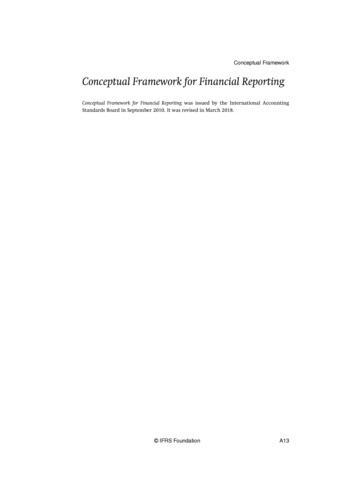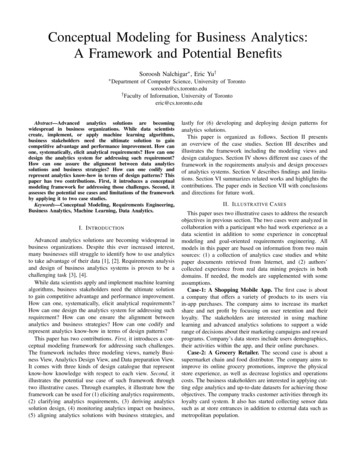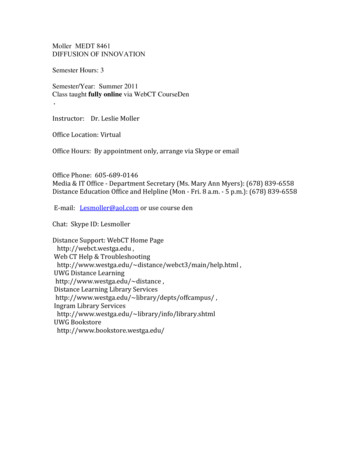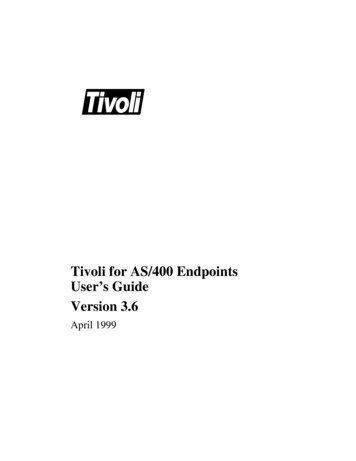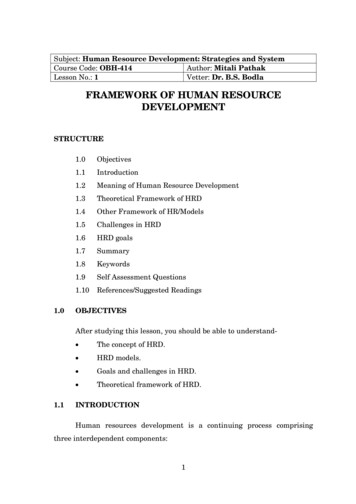
Transcription
A Conceptual Framework for the DirectMarketing Process using BusinessIntelligenceA thesis submitted for the degree of Doctor ofPhilosophyByAdel FliciBrunel Business SchoolBrunel UniversityJuly 2011
AbstractDirect marketing is becoming a key strategy for organisations to develop and maintainstrong customer relationships. This method targets specific customers with personalisedadvertising and promotional campaigns in order to help organisations increasecampaign responses and to get a higher return on their investments. There are, however,many issues related to direct marketing, ranging from the highly technical to the moreorganisational and managerial aspects. This research focuses on the organisational andmanagerial issues of the direct marketing process and investigates the stages, activitiesand technologies required to effectively execute direct marketing.The direct marketing process integrates a complex collection of marketing concepts andbusiness analytics principles, which form an entirely ‘self-contained’ choice fororganisations. This makes direct marketing a significantly difficult process to perform.As a result, many scholars have attempted to tackle the complexity of executing thedirect marketing process. However, most of their research efforts did not consider anintegrated information system platform capable of effectively supporting the directmarketing process. This research attempts to address the above issues by developing aconceptual framework for the Direct Marketing Process with Business Intelligence(DMP-BI). The conceptual framework is developed using the identified marketingconcepts and business analytics principles for the direct marketing process. It alsoproposes Business Intelligence (BI) as an integrated information system platform toeffectively execute the direct marketing process.In order to evaluate and illustrate the practicality and impact of the DMP-BI framework,this thesis adopts a case study approach. Three case studies have been carried out indifferent industries including retailing, telecommunication and higher education. Theaim of the case studies is also to demonstrate the usage of the DMP-BI frameworkwithin an organisational context. Based on the case studies’ findings, this thesiscompares the DMP-BI framework with existing rival methodologies. The comparisonsprovide clear indications of the DMP-BI framework’s benefits over existing rivalmethodologies.2
ContentsABSTRACT . 2LIST OF TABLES . 7LIST OF FIGURES. 8CHAPTER 1: INTRODUCTION . 111.1 Introduction . 111.2 Background . 111.3 Motivations and Research Questions . 121.4 Research Aim and Objectives . 141.5 Research Methodology . 151.6 Contributions . 151.7 Structure of the Thesis . 17CHAPTER 2: LITERATURE REVIEW . 202.1 Introduction . 202.2 The Development of the Direct Marketing Discipline . 202.2.1 The Growth and Origins of Direct Marketing . 202.2.2 Direct Marketing Defined . 222.2.3 Direct Marketing Terms . 232.2.4 Direct Marketing & Customer Relationship Management (CRM) . 242.3 Direct Marketing Concepts and Practices . 252.3.1 Direct Marketing Process . 252.3.2 Direct Marketing Applications . 272.3.2.1 Segmentation Application . 272.3.2.2 Targeting Application . 352.3.3 Direct Marketing & Analytical Techniques . 372.3.3.1 Standard Statistical Techniques . 372.3.3.2 Data Mining/Machine Learning Overview . 412.4 Research on Direct Marketing. 502.4.1 The Technical School . 512.4.2 The Social School . 522.4.3 Existing Process Models in Direct Marketing . 532.4.4 Data Mining Methodologies & Knowledge Discovery . 552.4.5 Limitations of Existing Direct Marketing Process Models . 583
2.5 Chapter Conclusion . 60CHAPTER 3: DEVELOPMENT OF THE PROPOSEDCONCEPTUAL FRAMEWORK . 613.1 Introduction . 613.2 Marketing Concepts and Business Analytics . 613.2.1 Scope of this Study . 623.2.2 Marketing Database. 623.2.3 Business Analytics . 643.3 Information Systems & the Direct Marketing Process . 653.3.1 Business Intelligence Development . 663.3.2 BI Overview . 673.3.3 BI Capabilities . 683.4 The Conceptual Framework for the Direct Marketing Process with BusinessIntelligence (DMP-BI). 693.4.1 Process Models used to Develop the DMP-BI Framework . 693.4.2 BI Functions Used . 703.4.3 Direct Marketing Objectives . 733.4.4 Data Preparation . 743.4.5 Data Modelling . 753.4.6 Direct Marketing Planning . 783.5 Chapter Conclusion . 78CHAPTER 4: RESEARCH METHODOLOGY . 804.1 Introduction . 804.2 Research Philosophy . 804.2.1 Research Philosophy Adopted . 854.2.2 Justification of Qualitative Approach. 874.3 Proposed Research Method: Case Study . 894.4 Research Design . 924.4.1 The Research Design Components . 924.4.2 Research Design Adopted. 944.4.3 Case Study Design Adopted . 964.4.4 Evaluation of Case Study Quality . 974.5 Data Collection . 994.6 Data Analysis. 1004.6.1 Relying on Theoretical Propositions Strategy . 1004.6.2 Qualitative & Quantitative Strategy . 1014.6.3 Examining Rival Explanations . 1014.6.4 Analytical Technique Used. 1024
4.7 Reporting Case Studies . 1044.8 Ethical Considerations Related to Research . 1054.9 Chapter Conclusion . 106CHAPTER 5: CASE STUDY I SUPERMARKET PROMOTIONS. 1075.1 Introduction . 1075.2 Case Study Report . 1075.2.1 Introduction . 1085.2.2 An Overview of the Transaction Dataset . 1085.2.3 DMP-BI Application in Retailing . 1115.2.3.1 Direct Marketing Objectives . 1115.2.3.2 Data Preparation . 1115.2.3.3 Data Modelling . 1135.2.3.4 Direct Marketing Planning . 1245.3 Supermarket Case Study Evaluation . 1255.3.1 The DMP-BI Stages . 1255.3.2 BI Functions. 1275.3.3 The DMP-BI Structure . 1285.4 Chapter Conclusion . 129CHAPTER 6: CASE STUDY II TELECOMMUNICATION SECTOR. 1316.1 Introduction . 1316.2 Case Study Report . 1316.2.1 Introduction . 1326.2.2 An Overview of the Dataset. 1326.2.3 DMP-BI Framework Application in Telecommunication . 1336.2.3.1 Direct Marketing Objectives . 1336.2.3.2 Data Preparation . 1336.2.3.3 Data Modelling . 1356.2.3.4 Direct Marketing Planning . 1416.3 Telecommunication Case Study Evaluation. 1426.3.1 The DMP-BI Stages . 1426.3.2 BI Functions. 1436.3.3 The DMP-BI Structure . 1446.4 Chapter Conclusion . 145CHAPTER 7: CASE STUDY III HIGHER EDUCATION SECTOR. 1467.1 Introduction . 1465
7.2 Case Study Report . 1467.2.1 Introduction . 1477.2.2 An Overview of the Student Database . 1477.2.3 DMP-BI Application in Higher Education . 1497.2.3.1 Direct Marketing Objectives . 1497.2.3.2 Data Preparation . 1497.2.3.3 Data Modelling . 1517.2.3.4 Direct Marketing Planning . 1547.3 Higher Education Case Study Evaluation . 1557.3.1 DMP-BI Stages . 1567.3.2 BI Functions. 1577.3.3 The DMP-BI Structure . 1587.4 Chapter Conclusion . 158CHAPTER 8: CROSS-CASE STUDY EVALUATION ANDCOMPARISON . 1598.1 Introduction . 1598.2 Cross-Case Studies Evaluation . 1598.2.1 The DMP-BI Stages . 1608.2.2 The DMP-BI System Platform. 1638.2.3 The Iterative Process . 1648.2.4 Summary of Key Findings . 1648.3 Comparison & Discussion. 1658.3.1 Direct Marketing Objectives . 1658.3.2 Data Preparation . 1688.3.3 Data Modelling . 1688.3.4 Direct Marketing Planning . 1698.3.5 DMP-BI System Platform . 1698.3.6 Iterative Process . 1708.4 Chapter Conclusion . 170CHAPTER 9: CONCLUSIONS . 1729.1 Introduction . 1729.2 Summary of Contributions . 1729.2.1 Theoretical Contributions . 1729.2.2 Practical Contributions . 1749.3 Research Limitations . 1769.3.1 Contextual Constraints . 1769.3.2 BI Concept vs BI Technology. 1769.3.3 Methodological Limitations. 1779.4 Future Research . 1786
REFERENCES . 180APPENDICES . 189Appendix 5: Supermarket Dataset Variables . 1895.1 Appendix: Meat Products and their Description. 1895.2 Appendix: Data Key Fact Summary for the Supermarket Dataset . 190Appendix 6: Variables Summary . 191List of TablesTable 2.1: Segmentation Variable Classification . 28Table 2.2: Generic Social Grade Model. 30Table 2.3: Lifestyle statement examples . 34Table 2.4: Major lifestyle databases . 34Table 2.5: Standard Statistical Techniques . 38Table 2.6: Dataset for advertising expenditure and sales revenue . 39Table 2.7: Most common data mining and machine learning techniques for directmarketing applications . 42Table 3.1: DMP-BI Conceptual Framework Literature Summary . 71Table 3.2: Direct marketing scope identification . 73Table 3.3: Direct marketing data categories and variables . 74Table 4.1: A comparison of the key rhetoric of major IS research paradigms . 84Table 4.2: Case Study Tactics for Four Evaluation Criteria . 98Table 4.3: Rival Explanation Types with Brief Descriptions . 103Table 4.4: Six Illustrative Structures for Case Study Compositions . 105Table 5.1: Models’ Accuracy and Relevancy . 114Table 5.2: A Region’s sales, promotions and lifestage favoured more than other regions. 117Table 5.3: Summary of information revealed by Naïve Bayes model. 123Table 6.1: Predicting customer churn models accuracy . 1357
Table 7.1: System’s main features . 148Table 8.1: Key Patterns in Each Case Study . 162Table 8.2: The DMP-BI Framework vs Three Rival Methodologies . 167List of FiguresFigure 2.1: Elements of Promotion . 26Figure 2.2: Direct marketing applications using marketing database. 27Figure 2.3: Customer segments by value . 36Figure 2.4: Advertising impact on sales revenues . 39Figure 2.5: Simple neural network using function z 3 x 2 y 1 . 43Figure 2.6: A multilayer perceptron’s neural network with hidden layer usingbackpropagation algorithm . 44Figure 2.7: Decision tree for the example where each internal (non-leaf) node representsa test on an attribute. Each leaf node represents a class (Yes or No) to indicate whether acustomer is likely to purchase a computer . 45Figure 2.8: Clusters of homogeneous sub-populations of customers with “ ”representing the centre of the location . 46Figure 2.9: Two groups of objects classified as red and green, plotted in an analysisspace by two axes of similarity (two metrics) . 48Figure 2.10: A new object (white ball) position in the analysis space . 48Figure 2.11: Mapping of input data points to feature space, where linear separation ispossible. 50Figure 2.12: The personalisation process . 54Figure 2.13: The Iterative Personalisation Process . 55Figure 2.14: The CRISP-DM data mining methodology . 57Figure 2.15: Knowledge Discovery in Databases Process . 58Figure 3.1: A Marketing Database System Adapted . 63Figure 3.2: Evolution of BI tools . 67Figure 3.3: Inputs to BI tools . 67Figure 3.4: BI process diagram . 688
Figure 3.5: Direct Marketing Process with Business Intelligence (DMP-BI) Framework. 72Figure 4.1: Empirical Research Design . 95Figure 4.2: Case Study Design . 97Figure 5.1: Dataset Main Attributes . 110Figure 5.2: Example of neural network model results for London and the Midlands . 115Figure 5.3: Beef Products Sales in Different Regions using Decision Tree Technique120Figure 5.4: Naïve Bayes Model for Beef products Sales in each Region . 122Figure 5.5: The DMP-BI Framework Structural Links . 129Figure 6.1: Overall process used to build the neural network model . 137Figure 6.2: Neural Network Model with variable importance . 138Figure 6.3: Model Summary including its accuracy . 139Figure 6.4: A Cumulative lift chart for the neural network model . 140Figure 6.5: The incremental lift chart for the neural network model . 141Figure 7.1: The process of geocoding Brunel University’s address to a precise location. 150Figure 7.2: The new webpage with Virtual Earth Map . 151Figure 7.3: Students’ home addresses located within 50km of Brunel University . 153DedicationThis thesis is dedicated to my amazing Mother, Fatima-Zohra, my three beautifulSisters (Nesrine, Nardjes and Sara), my fabulous Brother (Boualem), my wonderfulGrandmother (Yamina) and my dearly departed Father, Grandfather and Uncle, LâadiFlici, Boukhari Touil, and Mohamed Touil – with love and gratitude.AcknowledgementI would like to express my gratitude to my supervisor Dr Kevin J. Lü for his guidance,advice and support during my PhD studies. I am also grateful to Dr Tariq Khan whosecomments and feedbacks on my research are appreciated.9
I would like also to thank all the members of the Business School at Brunel University,particularly, the IT team for their support throughout this journey. My thanks go to thestaff that helped me collect the data to complete my case studies. A special thank you toall my friends, especially, Mohamed Kherachi, Atmane Benkara, Zoheir Sahel,Mouloud Ameni and Sharif Abbasi for their moral support. I also would like to thankthe PhD students in the Business School and the Learning Technology Team at BrunelUniversity. I extend my gratitude to Douja, Habib, Assia and their wonderful Children.Last but not least, I would like to thank the lovely Asma Kahoul for her endless supportthroughout this journey.Publications Associated with this ThesisFlici, A. & Lü, K. 2011, "A Framework for Direct Marketing using BusinessIntelligence", The International Conference on Digital Information Processing andCommunications, Ostrava, Czech Republic.Flici, A. 2009, “A Direct Marketing Framework to Facilitate Data Mining Usage forMarketers: A Case Study in Supermarket Promotions Strategy”, Brunel Business SchoolDoctoral Symposium, Brunel University, London, United Kingdom.Flici, A. 2008, “A Systematic Evaluation of Business Intelligence Tools: AnInvestigation into Potential Tangible/Intangible Value”, Brunel Business SchoolDoctoral Symposium, Brunel University, London, United Kingdom.Flici, A. 2008, “Business Intelligence Tools: Toward an Evaluation Framework”,Graduate School Poster Conference, Brunel University, London, United Kingdom.Authors’ DeclarationI, Adel Flici, declare that the ideas, research work, evaluation and conclusions reportedin my PhD thesis A Conceptual Framework for the Direct Marketing Process usingBusiness Intelligence are entirely my effort, except where otherwise acknowledged. Ialso certify that this thesis contains no material that has been submitted previously, inwhole or in part, for the award of any other academic degree or diploma. Except whereotherwise indicated, this thesis is my own work.10
CHAPTER 1: INTRODUCTION1.1 IntroductionThis chapter provides an overview of this research and outlines the scope of this thesis.Section 1.2 presents the research background. Section 1.3 provides the motivations andresearch questions behind this thesis. Section 1.4 explains the research aim andobjectives. Section 1.5 describes the methodology used to evaluate the overall research.Section 1.6 outlines the expected research contributions. Finally, Section 1.7 describesthe overall structure of the thesis.1.2 BackgroundOrganisations operate in highly competitive markets and a volatile environment, wherecustomers’ purchasing behaviour is constantly changing and difficult to predict. In suchcompetitive markets, direct marketing has become a key method to enhance promotioncampaigns as well as develop strong customer relationships (Chen, Chiu & Chang2005); and (Martínez-López & Casillas 2008). Traditional one-size-fits-all generalmarketing techniques are no longer enough to develop effective marketing campaigns.Direct marketing methods are needed to increase marketing campaign responses and tolower costs. Unlike general marketing, which is a product-oriented strategy, directmarketing is a customer-oriented method. It uses customers’ details, commonly held indatabases, to understand their needs (Tapp 2008). This is achieved through a processwhich includes identifying customers’ characteristics to recognise their market valuesand predict the likelihood that they will respond to marketing campaigns (Rao, SteckelJoel H. 1998); and (Bose, Chen 2009).Direct marketing is becoming an increasingly popular strategy in many organisations,operating across a wide variety of indust
The direct marketing process integrates a complex collection of marketing concepts and business analytics principles, which form an entirely ‘self-contained’ choice for organisations. This makes direct marketing a significantly difficult process to perform. As a result, many scholars hav
